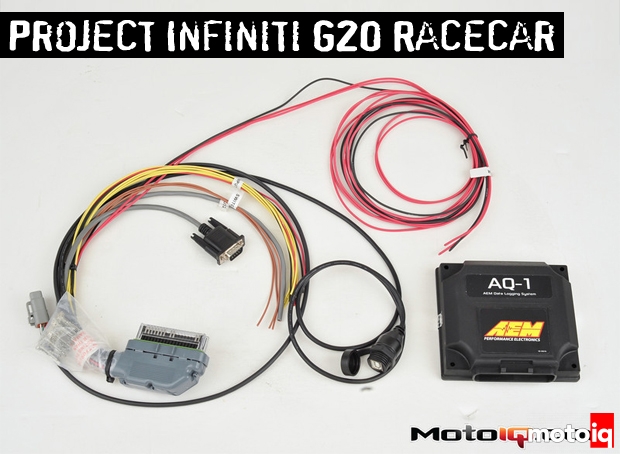 |
Project G20 Racecar: AEM AQ-1 Data Logger Install
By Steve Rockwood
My memory is horrible. Outside of which landmarks to aim for, my recollection of what I just did to nail that last corner just right is downright absent, and I couldn't really even tell you if it actually was nailed just right. Peak coolant temp on that last session? Hell if I know, seemed fine when I bothered to look at it. A/F ratios? The guy behind me said I shot flames on decel, so rich would be my guess. Intake temps? No clue. The fact is, there's a lot going on inside a racecar, and it requires a whole hell of a lot more of my attention than I can give. Enter the AEM AQ-1 Data Logger.
When we were originally approached by AEM to test out a new data logging product on Project G20 Racecar, we thought they must not have realized we were a privateer effort racing a car more commonly seen in the junkyard than on the street. Data loggers are expensive and complicated. Our previous opinion of them being that they cost more than it would take us to build #73's sister car. To use them, we were pretty sure you'd need a team of engineers and a row of computers. Turns out, we were just the type of user the AQ-1 Data Logger was designed for, and we were dead wrong on cost and user-friendliness.
First things first, let's get price out of the way. The AQ-1 is a tremendous bargain. Hand over four crisp one-hundred dollar bills, and you'll get change. The wiring harness is the only other AEM-specific item you'll need to get started, and you can either build your own by purchasing the mini-harness (part number 30-2906-0), or you can choose between two different completed AEM harnesses (18″ or 96″, part numbers 30-2906-18 and 30-2906-96, respectively) with each wire's function printed on it. We went with a completed harness to make our lives easier.
 |
| The AEM AQ-1 measures at only 4.8″ x 4.55″ x 1.44″, can mount in a myriad of orientations, and has an available pre-wired harness for ease of installation. |
The AQ-1 can record data from AEM gauges, vehicle functions like Throttle Position Sensor (TPS), and can receive input from any 2-wire temperature sensor, or 3-wire pressure sensor. There are a total of 11 channels that can be monitored, as well as an AEMnet connection, NMEA input from a GPS device, a serial port for data streaming, an internal 3-axis accelerometer and CAN-BUS input. Each channel has a logging rate of up to 1000 Hz, and all of this data is stored on a removable SD card (2GB included). The 11 channels are broken up thusly: 4 0-5V analog channels for items like temp sensors and analog MAF sensors, 4 0-5V or 0-16V channels that can also measure frequency for items like RPM and vehicle speed, and 3 switched to ground digital inputs for items like brake switches and solenoid activation.
For our car, we are going to monitor TPS signal, coolant temperature, boost pressure, A/F, brake activation, and RPM. Our Autometer gauges were all of the 1-wire variety and would not work with the AQ-1, so we flipped through the AEM catalog and picked up an air temperature sensor (part number 30-2010), water temperature sensor (30-2011), a 15psi pressure sensor (part number 30-2131-15), as well as a UEGO Sensor and in-line controller for A/F monitoring. We will need to add a NMEA GPS input as well, as our older car has a mechanical speed sensor.
 |
| Our UEGO sensor and in-line controller will keep tabs on A/F ratios throughout our runs. |
 |
| From left to right: AEM pressure sensor, air temperature sensor, and coolant temperature sensor. All AEM sensors come with weather plugs for reliability. |



